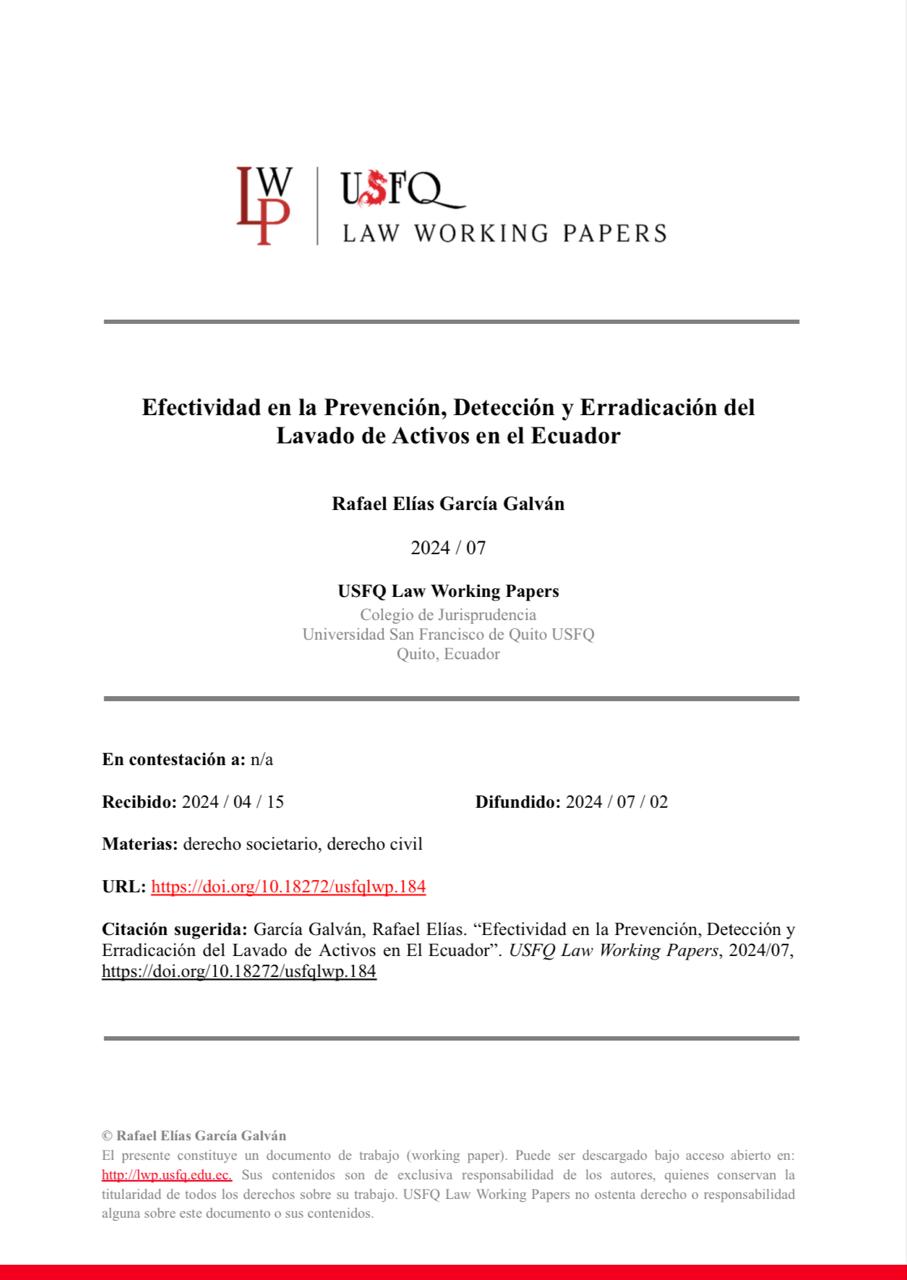Effectiveness in the Prevention, Detection and Eradication of Money Laundering in Ecuador
DOI:
https://doi.org/10.18272/usfqlwp.184Keywords:
Money Laundering, GAFI, UAFE, Mutual Evaluation, National Risk AssesmentAbstract
Currently, money laundering plays a crucial role for organized crime, as it enables them to maintain a constant cycle of illicit gains and perpetuate criminal activities. Therefore, it is essential to analyze the "Effectiveness in the Prevention, Detection, and Eradication of Money Laundering in Ecuador" through the statistics contained in the 2023 Mutual Evaluation. This analysis is indispensable to determine if this phenomenon, which negatively impacts society, is being adequately addressed, and to propose viable solutions that align with international standards to combat money laundering and terrorist financing.
Upon examining the statistics, it becomes evident that despite the fact that drug trafficking is the most condemned and significant predicate offense for money laundering, it is not given the same priority in investigations related to money laundering. This situation allows illegal activities to persist in society as they have a continuous source of financing. Thus, combating money laundering is relevant in preventing illicit activities perpetrated by organized crime, safeguarding the integrity of the financial system, combating criminal organizations, and strengthening the rule of law.
Conducting parallel financial investigations alongside predicate offense investigations is crucial to effectively stop crime financing. This approach will curb illegal activities and prevent illicit gains from perpetuating an endless cycle of crimes. Combating money laundering represents a challenge that requires the collaboration of various institutions and the adoption of efficient strategies to protect society and preserve the integrity of the legal and financial system of the country.
References
Ley Orgánica de Prevención, Detección y Erradicación del Delito de Lavado de Activos y del Financiamiento de Delitos (Registro Oficial Suplemento 802 del 21 de julio del 2016) (LOPLAFIP).
Fiscalía General del Estado, Resolución N. 106-FGE-2014 del 17 de octubre de 2014.
ALBÁN GÓMEZ, Ernesto, Manual de Derecho Penal Ecuatoriano Parte General, Tomo I, 3ra edición, 2018, p.101.
ARBULÚ, José, Derecho Administrativo Sancionador en la Prevención del Lavado de Activos, 2015, p. 18-22.
ARBULÚ, José, Lavado de Activos Gestión del Riesgo, 2018, p. 17.
BERTAZZA, Humberto J. y D’ALBORA, Francisco J. et al., Tratado de Lavado de Activos y Financiación del Terrorismo, Tomo I, 2012, p. 30.
BLANCO CORDERO, Isidoro, El delito de blanqueo de capitales, 2002, p.93.
GARCÍA, Percy, El Delito de Lavado de Activos, 2013, p. 14-25.
Grupo de Acción Financiera Internacional (GAFI), GUIA PARA LAS INVESTIGACIONES FINANCIERAS, junio 2012. Traducción realizada por GAFISUD en el marco del Proyecto GAFISUD-Unión Europea.
Grupo de Acción Financiera de Latinoamérica (GAFILAT), Informe de Evaluación Mutua de la República del Ecuador, enero 2023.
Grupo de Acción Financiera de Latinoamérica (GAFILAT), LAS RECOMENDACIONES DEL GAFI: ESTÁNDARES INTERNACIONALES SOBRE LA LUCHA CONTRA EL LAVADO DE ACTIVOS, EL FINANCIAMIENTO DEL TERRORISMO Y DE LA PROLIFERACIÓN, traducción realizada por el GAFILAT, con la autorización del GAFI. Idioma oficial del documento: inglés/francés.
Grupo de Acción Financiera de Latinoamérica (GAFILAT), ¿QUÉ ES EL GAFILAT? Trabajando en equipo regionalmente, (s.f.) URL https://www.gafilat.org/index.php/es/gafilat/que-es-gafilat/ 25/06/2023.
HERNÁNDEZ QUINTERO, Hernando, El lavado de activos, 5ta edición, 2021, p. 38.
LAMAS PUCCIO, Luis, LAVADO DE ACTIVOS Y OPERACIONES FINANCIERAS SOSPECHOSAS, 2016, p. 95.
MENDOZA LLAMACPONCCA, Fidel Nicolás, LAVADO DE ACTIVOS Y CRIMINALIDAD EMPRESARIAL, 2022, p. 80.
MERA, Carla, Ecuador: El GAFILAT contribuye a la seguridad de las personas y ayuda a proteger la integridad del sistema financiero, (s.f.) URL https://www.gafilat.org/index.php/es/miembros/ecuador consultado 25/06/2023.
MEZGER, Edmund, Derecho Penal, Tomo I, 2014, p. 21.
MIR PUIG, Santiago, Derecho Penal Parte General, 10ma edición, 2016, p.146.
ROXIN, Claus, Derecho Penal Parte General, Tomo I, 2da edición, 2010, p.51-193.
SCHROEDER, Friedrich-Christian, El lavado de activos como delito contra el prevalecimiento del derecho penal, en CARRIÓN, Juan y VIVEIROS, Carlos, El delito de lavado de activos : aspectos sustantivos, procesales y de política criminal, 2017, p.22.
YÁVAR NUÑEZ, Fernando, Orientaciones desde el art. 1 al 250 COIP Código Orgánico Integral Penal, 2016, p. 718.
ZAMBRANO PASQUEL, Alfonso, Derecho Penal Parte General, 2017, p.37.
Fiscalía General del Estado (FGE), UNIDAD ANTILAVADO DE ACTIVOS, (s.f.) URL https://www.fiscalia.gob.ec/unidad-antilavado-de-activos/ 02/07/2023.
Policía Nacional del Ecuador, UNIDAD ANTILAVADO DE ACTIVOS (ULA), (s.f.) URL https://www.policia.gob.ec/unidad-de-lavado-de-activos/ 02/07/2023.
Unidad de Análisis Financiero y Económico (UAFE), Evaluación Nacional de Riesgos Informe Ejecutivo, abril 2021.
Unidad de Análisis Financiero y Económico (UAFE), LA UAFE, (s.f.) URL https://www.uafe.gob.ec/la-institucion/ 01/07/2023.
Unidad de Análisis Financiero y Económico (UAFE), LA UAFE, (s.f.) URL https://www.uafe.gob.ec/mision-vision-valores/ 01/07/2023.

Posted
License
Copyright (c) 2024 Rafael García Galván

This work is licensed under a Creative Commons Attribution-NonCommercial 4.0 International License.
